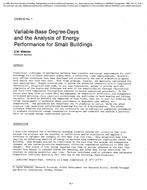Description
Traditional techniques of estimating building heat transfer and energy requirements for small buildings have utilized published degree-days, a relatively crude approximation. Recently, more refined techniques have been developed and occasionally the uses of simulation programs with hourly data have been used. Such large programs, however, are generally impractical for most applications. Simple correlations to define the effective indoor-to-outdoor temperature differential, integrated over time, to any base temperature, appear to provide both the simplicity of the degree-day technique and most of the sensitivity to seasonal fluctuations and short-term temperature fluctuations inherent in hourly analytical procedures. To the extent that heat flow is linear with and dependent on temperature difference, the fundamental principles governing these empirical correlations are applicable to both heating and cooling analysis. As well as defining the magnitude of heat flows, they can be used for modeling the energy requirements of equipment whose performance is dependent upon ambient air temperatures. Two procedures are described; one is graphical in nature, while the other requires some repetitive calculations requiring the use of a microcomputer. The second technique enhances the potential for the interactive use of substantial analytical procedures to evaluate alternative energy conservation strategies and tradeoffs and provide a practical basis to optimize energy conservation options.
Citation: Symposium, ASHRAE Transactions, 1985, vol. 91, pt. 1B, Chicago
Product Details
- Published:
- 1985
- Number of Pages:
- 9
- File Size:
- 1 file , 810 KB
- Product Code(s):
- D-CH-85-19-1




